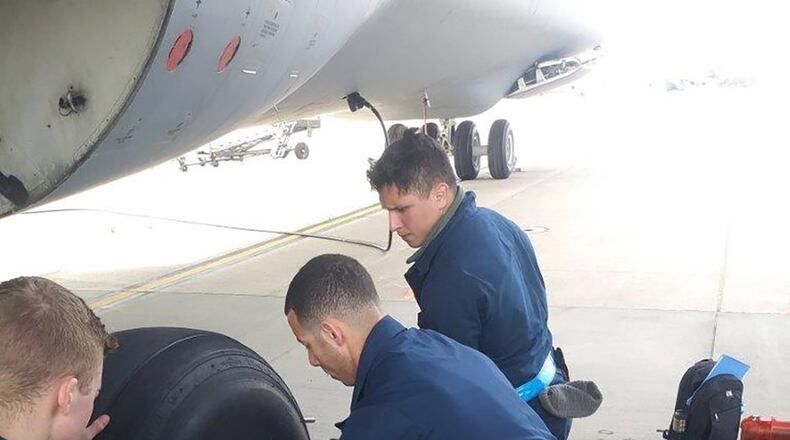Each C-5 tire wears down approximately 0.002 inches per landing on an aircraft that has 28 tires. The current tire-changing method is performed several times a week. It is a complicated multistep procedure that requires up to five people working together for an extended period of time with a number of safety risks due to the size and weight of the tires and tools.
The design of the hub consists of a single large nut that holds the wheel in place. Heavy tools ensure placement of the wheel (almost four feet in diameter). The spanner wrench, used to tighten the nut, weighs 15 pounds and has to be held accurately in position so the nut can be tightened to the appropriate torque specification.
There is currently no worthwhile technique to position and hold the heavy spanner wrench in place on the nut while tightening. The torque required to hold the wheel on the plane while using the long torque wrench exacerbates the problem, causing the spanner wrench to roll off the nut when an abundance of force is applied.
The current method of engaging the spanner wrench involves a maintainer who has to lay on the ground while pressing his or her feet against the wrench to hold it in place. This method can cause faulty torque readings along with placing the maintainer in an awkward and risky position beneath the heavy spanner wrench.
The AFRL JFWORX team has invented a new tool that allows a single Airman to position and secure the spanner wrench in place, making it easier and safer to tighten the wheel. A footplate and an upright handle allow a single maintainer to apply a large axial force against the spanner wrench, keeping it seated while torque is applied. By reducing the manpower required to handle and position the spanner wrench, the entire tire change process now takes only three maintainers.
The new spanner wrench support also includes features designed into the faceplate to allow for the use of various spanner wrenches. The faceplate is mounted on a sealed ball bearing so that it can rotate with the spanner wrench while the nut is being tightened. This prevents the tool from affecting the torque reading and results in a more accurate procedure. Height and angle adjustability on the main body of the tool make it useful in any situation for any tire on the airplane.
“Developing this tool and working with the JFWORX team has been a rewarding experience with a great solution,” said Tech. Sgt. Jason Huestis, a maintainer from Travis Air Force Base, California. “We look forward to getting this tool formally adopted into the tire-change process, and we can’t thank the JFWORX team enough for their hard work.”
J.D. Bales, of the JFWORX team, helped design the tool so it could be locally manufactured at each base where it is needed; however, the JFWORX team is working with maintainers at both Travis and Dover Air Force Base to identify a fielding method that works for them.
“Enabling the warfighter to quickly return to operations is a must,” said Bales. “Lowering the manpower requirement for a tire change from five airmen to three is a significant advantage when you are flying planes with 28 tires.”
JFWORX, initiated in 2014, arose from the AFRL Materials and Manufacturing Directorate’s Company Grade Officer Initiative Program, which gave junior military officers the opportunity to grow their expertise through leading and executing mission-specific projects for the immediate benefit of the warfighter. Directorate leadership expanded the program to encompass the entire Materials and Manufacturing Directorate junior workforce, including civilian members.
The idea behind the unique program is to grow technical and management expertise early in researchers’ careers and to provide mid-level professionals the opportunity to serve as mentors, thereby preparing them to become future leaders within the organization. Projects that address urgent needs of troops in the field serve as the vehicles through which these skills are fostered.
The primary technical focus of JFWORX projects is the rapid development of customer-centric projects that will provide real-world solutions to existing warfighter needs.
JFWORX develops near term, innovative solutions to warfighter operational needs. Department of Defense organizations interested in working with the JFWORX team can contact the Materials and Manufacturing Directorate’s Corporate Communications team at AFRL.RX.CorpComm@us.af.mil to learn more.
The Air Force Research Laboratory is the primary scientific research and development center for the Air Force. AFRL plays an integral role in leading the discovery, development, and integration of affordable warfighting technologies for our air, space, and cyberspace force. With a workforce of more than 11,000 across nine technology areas and 40 other operations across the globe, AFRL provides a diverse portfolio of science and technology ranging from fundamental to advanced research and technology development. For more information, visit www.afresearchlab.com.
About the Author
